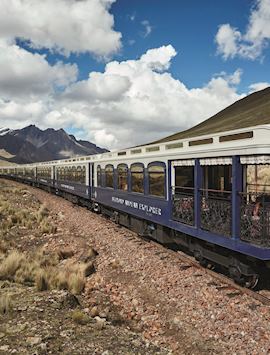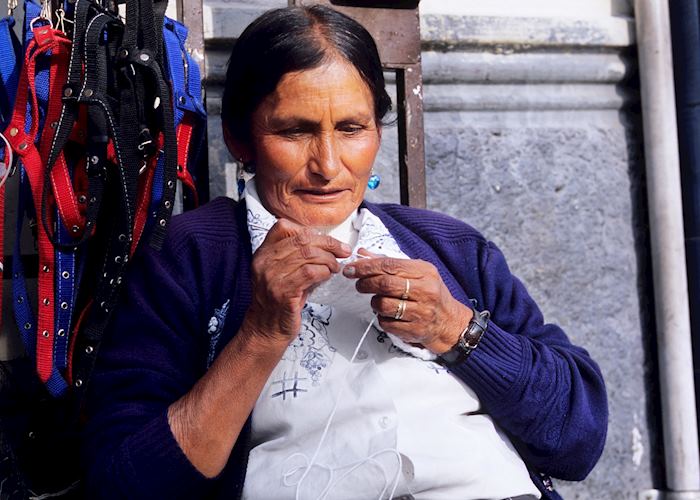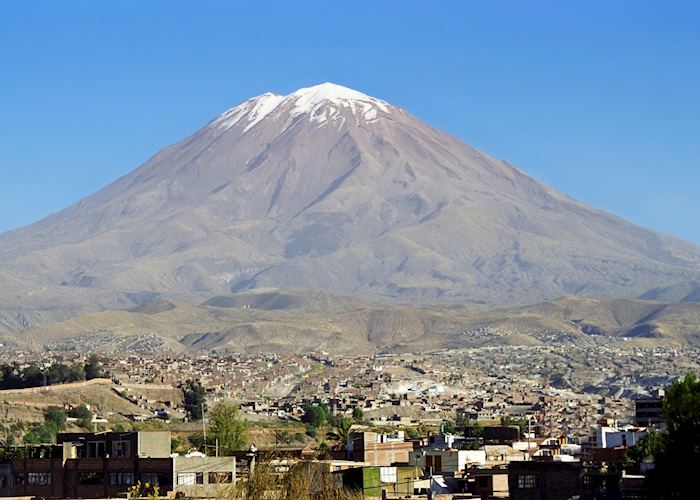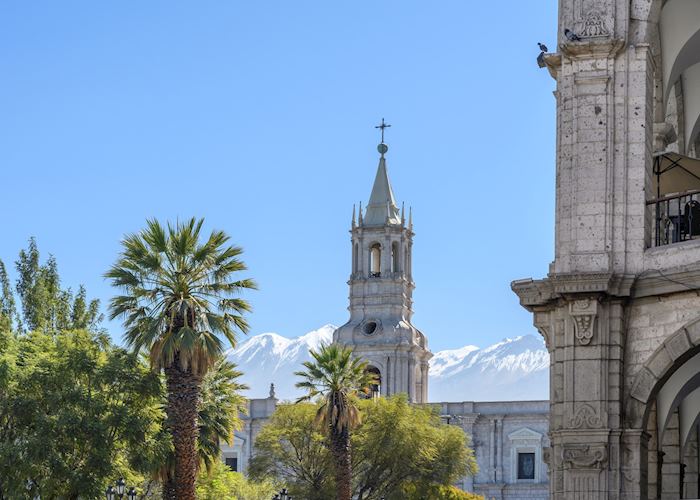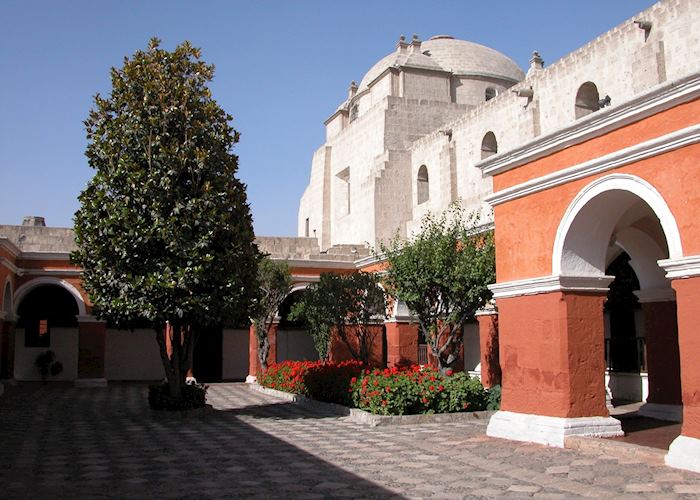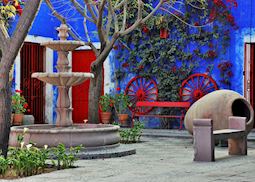Jump to:
Sitting up on a plain that brushes the Andes, Arequipa is Peru’s white city. Built by local hands to the European mindset, conceived by Spanish colonialists and constructed by indigenous craftsmen, its moniker comes from the sillar used as a major building material. A type of local white volcanic stone, sillar defines the colonnaded architecture of the Plaza de Armas, the city’s main square.
A long, lean cathedral runs the length of one edge, tapering upward with Baroque gusto into two pinnacled towers that measure as the city’s high point and, from certain angles, frame the volcano El Misti.
The Spanish brought their European architectural thinking to the table in Arequipa, but they needed local assistance in shoring up their grand building projects, in an area where earthquakes were sudden, frequent and catastrophic. They turned to the local masons to render their designs with shock-resistant robustness, and what you see in Arequipa is a marriage of foreign style and local building prowess.
Arequipa is very much in the grip of the Andes — both a blessing and in past times a curse. A trio of volcanoes beyond the city, surmounted by the still-active cone of El Misti, are a scenic yet inescapably volatile backdrop. Earthquake tremors still rattle Arequipa on a near-monthly basis.
Juanita
Mount Ampato, northwest along the range from El Misti, unexpectedly gave Arequipa one of its greatest treasures following a landmark discovery there in 1995. In the September, American anthropologist Johan Reinhard had been climbing on Ampato, as part of his research into Inca ceremonial sites.
When Reinhard came across a bundle wrapped in cloth, he soon understood it contained the remains of a girl, mummified by the freezing conditions, and he’d come upon an Inca sacrifice. The female mummy — ceremonially dressed and with a silver clasp pinning her burial shawl — became known as Juanita.
Juanita went on display in Arequipa in 1996. You can view her in her refrigerated display case at the Museo Santuarios Andinos, not far from the Plaza de Armas.
Santa Catalina convent
Gray stone walls give little inkling of what awaits inside at Arequipa’s other foremost attraction, the Monasterio de Santa Catalina (Santa Catalina Convent). But, once you’ve passed through the studded, wooden entrance door, you find yourself wandering around a village-sized arrangement of russet and cobalt-blue painted streets and courtyards. Pots of geraniums prettify doorsteps and crank up the saturation levels even further.
 The convent is a miniature city of spirituality within a city. It was the 16th-century brainchild of Doña María de Guzmán, a young, well-to-do widow with the necessary funds and religious zeal. She was also one of the first inhabitants, and the women who joined her into a life of servitude to God hailed from a mix of European and indigenous backgrounds.
The convent is a miniature city of spirituality within a city. It was the 16th-century brainchild of Doña María de Guzmán, a young, well-to-do widow with the necessary funds and religious zeal. She was also one of the first inhabitants, and the women who joined her into a life of servitude to God hailed from a mix of European and indigenous backgrounds.
What they all had in common was the required financial backing from their family to buy their admission into the order. It was an exclusive, and reputedly extravagant, club of the time. Not until the late 1800s did the convent begin to reign in its excesses, after the pope got wind of the ungodly luxury in which the nuns lived and put his foot down.
Over the course of an hour, a local guide (who’s likely to be born and bred in Arequipa) can show you around the complex. Your guide will highlight the realities of life here and the legends attached to its wealth, as you dip from solemn, dusky interiors into the glaringly sunlit lanes and cloisters.
You’ll walk through the silencio arch, the crossing point for new nuns to make their vow of silence. On Córdova Street you can see the nuns’ rooms, and in the Profundis Room where the recently departed sisters were mourned.
Joining the convent signed you up to lifelong confinement, with a single get-out clause after completing a four-year stint as a novice nun (though to leave meant a sure-fire disgrace to the girl). You can see the visiting room where nuns could maintain a little contact with their family through gridded windows in the wall. Some two dozen nuns still call the convent home, 400 years after it was built.
Although we think Arequipa demands attention in its own right, you can also view it as a useful place to begin to adjust to the high altitude before journeying farther into the Andes.
Adventure activities near Arequipa
Arequipa also makes a good base if you’re interested in white-water rafting or mountain biking in an Andean setting. An hour from the city’s heart brings you to Chapi Chico, where you can start rafting the lurching rapids of the Chili River, which meanders its way between the El Misti and Chachani volcanoes. It’s suitable for beginners as well as veterans.
Guided mountain biking trips begin a two-hour drive from Arequipa, up on the slopes of Chachani. You’ll bike down dirt tracks and head cross-country, before finishing on the fringes of the city in the late afternoon.
Best time to visit Arequipa
Arequipa has a dry desert climate and can be visited all year round, but bear in mind that another mummy understudies for Juanita from January to April. For rafting, it’s also worth knowing that the water levels are generally higher and the rapids more dramatic during the months of April, May, October and November.
who's been there
-
617-223-4521617-223-4920
- Make an inquiry
Suggested itineraries featuring Arequipa
Our itineraries will give you suggestions for what is possible when you travel in Arequipa, and they showcase routes we know work particularly well. Treat them as inspiration, because your trip will be created uniquely by one of our specialists.
Places near Arequipa
- Colca Canyon 66 miles away
- Puno 108 miles away
- Lake Titicaca 140 miles away
- Cuzco 202 miles away
- Sacred Valley 226 miles away
- Machu Picchu 234 miles away
Photos of Arequipa
Our expert guides to exploring Arequipa
Written by our specialists from their own experiences of visiting Arequipa, these guides will help you make the most of your time there. We share both our practical recommendations and the best ways to appreciate Arequipa at its best.
-
Extending your stay in Arequipa: Peru’s White City ![Colonial buildings, Arequipa, Peru]()
Extending your stay in Arequipa: Peru’s White City
Extending your stay in Arequipa: Peru’s White City
Guarded by three volcanoes and renowned for its white-brick Spanish-colonial buildings, pink sunsets and food scene, Arequipa is more than just a base in which to acclimatize at the start of your Peru trip, as Fathom, our Latin America specialist, explains.
Read this guide
Accommodation choices for Arequipa
We've selected a range of accommodation options for when you visit Arequipa. Our choices usually come recommended for their character, facilities and service or location. Our specialists always aim to suggest properties that match your preferences.
-
![Casa Andina Private Collection, Arequipa]()
Casa Andina Premium Arequipa
Arequipa
Ideas for experiencing Arequipa
Our specialists seek out authentic ways to get to know the places that could feature in your trip. These activities reflect some of the experiences they've most enjoyed while visiting Arequipa, and which use the best local guides.
-
Arequipa City tour ![Santa Catalina Monastery, Arequipa]()
Arequipa City tour
Arequipa City tour
This tour concentrates on the beautiful Santa Catalina Convent, a walled colonial town within a city. Opened to the public in 1970 after four centuries of secrecy, the remaining nuns have moved to a private corner of the convent allowing visitors to wander through the peaceful cobbled streets.
View details




